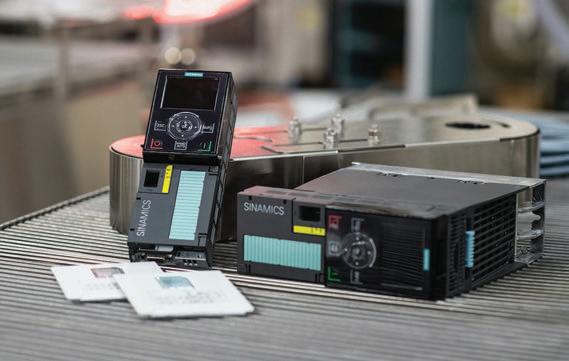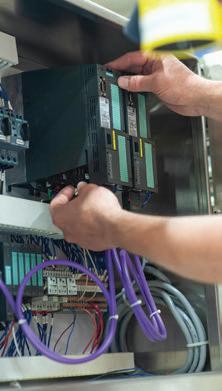
12 minute read
NEWS
British Sugar’s “Factories of the Future” Initiative Includes a Private 4G Network
By David Miller
Senior Technical Writer
As the use of mobile technologies such as augmented reality and autonomous mobile robots in manufacturing continues to grow, wireless connectivity on the plant floor is fast becoming an imperative. In addition to making non-fixed automation possible, wireless networks also allow end users to integrate data more easily from large quantities of connected devices spread over a wide area.
However, traditional Wi-Fi may lack the efficiency, security, and control that missioncritical operations require. For instance, in legacy environments that were not designed with wireless connectivity in mind, fluctuations in temperature, humidity, moisture, and vibration, machines that give off an electrostatic charge, and even the placement of metal or glass walls may interfere with the transmission of reliable wireless signals. High device density may also compromise reliability in settings where hundreds or even thousands of sensors may need to be connected to the network. Moreover, the limited range of Wi-Fi may not be suitable for the scale of many industrial operations.
As a result, many manufacturers are turning to private cellular networks—some of which employ 5G—to provide connectivity in their facilities. One such example is British Sugar, which has recently partnered with telecommunications company Virgin Media 02 Business and Nokia to roll out a 4G private cellular network across multiple factory sites spanning a large geographical area. The network is being adopted in conjunction with British Sugar’s “Factories of The Future” upgrade initiative.
According to British Sugar, the new network will allow them to more effectively introduce new technologies such as artificial intelligence (AI), automated production lines, robots, and drones. AI will be used to monitor factory operations in real-time and predict maintenance and potential downtime in advance, reducing waste and downtime and cutting costs. Going forward, the company plans to further embrace Industry 4.0 through a planned seven-year partnership with Virgin Media 02 Business and Nokia. Currently, more than 15 digital manufacturing use cases have been planned for British Sugar’s 4G network, which has been designed to be easily upgradable to 5G.
“During testing we were encouraged by the early results seen and as we have begun to roll out the targeted priority use cases to our users; they have been quick to give feedback about the time savings they have seen— with new plant commissioning, plant testing and day-to-day diagnostic processes being highlighted in particular,” said Nick Smalley, program manager at British Sugar.
Cellular networks—whether 4G or 5G— have several advantages over Wi-Fi for operators of expansive industrial facilities. For one, they provide broader coverage with fewer access points, granting end users the network range they need. Beyond that, they have a higher end-device capacity, meaning that the integration of many connected devices will not interfere with reliability. Finally, cellular networks have built-in encryption and require that end-devices have a SIM (subscriber identification module) card to connect, which limits points of entry and bolsters cybersecurity.
While these benefits can be attained from a public cellular network, a dedicated private network tailored specifically to British Sugar’s operational needs can provide better coverage and more reliable performance, since it does not require its bandwidth be shared with others. Furthermore, it allows the company to maintain internal control of its confidential data.
Amazon and MassRobotics Partner for Robotics Accelerator
By David Miller
Senior Technical Writer
Among the engineering design and development fields, automation technology creators face a unique conundrum. On the one hand, innovation is essential to new automation technology development, and new entrants are often well suited to provide it. At the same time, it can be difficult for these small companies to break into an already-saturated field like industrial technology. Because of this, startup incubators and accelerators play an important role in facilitating their growth. Incubators can grant companies facilities to work in, resources such as equipment and expertise, and opportunities to acquire funding via a network of potential partner companies.
These organizations take a light-touch approach, and typically house companies for several years while they engage in their own, self-directed process of growth. By contrast, accelerators take a more hands-on approach and work with a smaller selection of companies more intensively for a brief period of time. If picked up by an accelerator, a startup can expect highly specialized mentorship and education as well as direct investment.
Recently, Boston-based incubator MassRobotics has announced that, in addition to the resident companies it hosts, it will be delivering a new Amazon Web Services Robotics Startup Accelerator. The aim of this initiative is to address challenges commonly encountered in the development of automation, robotics, and Industrial Internet of Things technologies by providing participating companies with the resources they need to prototype, test, and commercialize their products. In addition, companies will have access to Amazon Web Services’ cloud technical resources and partner network.
The accelerator will take place over four weeks and will include technical and business mentorship opportunities. Ideal applicants include robotics hardware and software startups seeking to use Amazon Web Services as a key component in their products and offerings. Moreover, companies who wish to be involved must be privately held startups with less than $10 million in revenue and less than $100 million in funding raised to date. No prior experience with Amazon Web Services or participation in previous accelerators is required.
Companies selected to participate will receive: Specialized training in the deployment of Amazon Web Services for robotics applications; up to $10,000 in promotional credits for the use of Amazon Web Services’ Internet of Things, robotics, and machine learning services; mentoring from experts; opportunities for co-marketing with Amazon Web Services through the publication of blogs and case studies as well as proofof-concept projects; guidance pertaining to business development and investment from MassRobotics; and networking opportunities through contact with other participating startups and the Amazon Web Services partner network.
Read more about MassRobotics here.

Krispy Kreme’s Drive Retrofit
By David Greenfield
Director of Content / Editor-in-Chief
Doughnuts are, obviously, the first thing that comes to mind when you hear the name Krispy Kreme. But for those with an interest in automation and manufacturing, you’re missing a big part of the Krispy Kreme story if you’re not familiar with the company’s machine building operations.
This aspect of Krispy Kreme’s operations is nothing new, as the company has designed and built proprietary machines from the company’s early days. Today, the company’s headquarters in Winston Salem, N.C., is home to a 105,000-sq.-ft. manufacturing facility that houses research, design, testing, engineering, and production operations.
The machines and processing equipment built there use Siemens drives and controls,


The retrofi t kit from Think PLC was developed to replace older Siemens Micromaster drives with Siemens Sinamics G120 drives. Source: Siemens


Betson and Cole retrofitted every Krispy Kreme store in Australia in five days using their technology retrofit kit concept. Source: Siemens
A store can produce a thousand dozen doughnuts per hour. Pump motor drive performance in the store can be seen through the Siemens TIA portal to diagnose, troubleshoot, maintain, and prevent disruptions to production flow. Source: Siemens
integrated by Think PLC, the automation engineering consultant to Krispy Kreme.
“They engineer and manufacture all of their production machines, from extruders and conveyors through to the packaging, including their famous glaze waterfall,” says Bobby Cole, president of Think PLC.
Cole says the speed at which an extruded doughnut moves through the store is “a very, very big deal. Throughout the process, the shortening is kept within an exact range of temperature. Doughnuts are cooked on both sides for a precise number of seconds and the cooling conveyor cycles through the store at a set number of minutes.”
Updating via retrofit
Recently, Krispy Kreme has been updating its manufacturing operations based on insights from the company’s service technicians, store managers, and customers. Patrick Betson, Krispy Kreme’s director of equipment manufacturing, says this feedback has led to several improvements addressing increased uptime and mean time before failure.
“Before there was much publicity about Industry 4.0 and IoT (Internet of Things), Bobby Cole and I often talked about the data that could be generated by more advanced machine monitoring,” says Betson. “It became increasingly clear that by integrating the latest Siemens drives and controls on our machines, and connecting them using Profinet communications, we could start putting that data to work.”
To enable consistent automation upgrades and retrofitting at existing stores, and plan for the roll out of equipment at new stores, Think PLC needed to determine the fastest and most cost-efficient way to integrate Siemens Sinamics G120 variable frequency drive (VFD) technology in more than 600 stores worldwide.
This led Betson and Cole to develop a retrofit kit that would allow every store to quickly add new components and software to their existing hardware.
The key to Think PLC’s retrofit idea was to leverage the SD cards used on Siemens drives and controls already in Krispy Kreme stores. This was a viable approach because Krispy Kreme maintained each store’s unique set of machining and processing parameters on the SD cards. As a result, stores only need a local contractor to upgrade the legacy control panels, including parts for safety and power wiring.
“The main purpose of the kit was to

replace the older Siemens Micromaster drives with Siemens Sinamics G120 drives,” Cole explains. “The SD card in the kit has software that we modified; and with a couple flips of some switches, the drive is automatically programmed. Someone with absolutely no control experience can reload the new software into the new drives and the new PLCs.”
According to Cole, the retrofit kit enables a store to replace its drives and controls in about two hours—saving significant time and costs associated with having a control technician travel to a Krispy Kreme store to perform the work.
To prove the retrofit kit concept, Krispy Kreme and Think PLC tested the kit’s installation and use in their manufacturing plant in Winston-Salem, N.C., followed by tests at various stores in the region. During these tests, the new drives and PLCs installed smoothly and the SD cards automatically updated and matched all previous store parameters. To further test the concept, Cole and Betson retrofitted every Krispy Kreme store (more than 30) in Australia in five days using the kits.
Fry control
During the doughnut frying process, the pumping of heated shortening is critical to maintaining optimal doughnut quality and product count. When the flow rate is not maintained at the desired constant, viscosity issues become a problem as dough bits cannot be filtered out of the melted shortening properly. This leads to temperature variances, causing hot spots to develop.
The Sinamics G120 drive addresses these pump motor issues while reporting the operational status of each motor. The drive also ensures that pump motor temperatures are kept below the threshold for heat damage.
Cole explains the drive can address pump motor issues through its ability to set and hold a curve that assures the most efficient flow at a low speed and a high speed—from 7 hertz to 90 hertz. With the new drives, “accuracy of the fry time has increased by 12%, resulting in a more consistent product with less waste yield,” he says. “A big advantage of the drive is that it can run a motor slow without the usual rise in motor temp. When you run a motor at very low hertz, it generates a lot of eddy current. It gets so hot, that you can’t touch the motor. And when you overheat the laminations of a motor, you greatly decrease the life of the motor. But we can monitor each drive through the Siemens TIA (Totally Integrated Automation) portal, and we’ve seen the amperage reduced by almost 17%, and the temperature of the motor reduced by 34%. We expect this will more than double the life expectancy of every pump.”
The Sinamics G120 drives also address worker safety issues through their triplequadruple redundancy, says Cole. “The new drives and PLCs being retrofitted into every store integrate with the existing Siemens safety monitoring circuitry, including the automated safety mechanisms and E-stop buttons. For example, if a hose were to break on the shortening pump, the flow stops within 100 milliseconds,” he says.
Remote access via TIA
Using Siemens TIA portal, Think PLC can access any of the Siemens G-120 drives remotely.
Cole describes using the TIA portal via his smartphone as being like standing in a Krispy Kreme store at the drive’s operator interface.
“When you open the door to the drive, a large display presents any fault messages,” he says. “You select a fault message and you’re given the related fault code that, in the past, you would need to look up in the user’s manual. Now, all the information you need—the details, what to check, how to reset—are on the display. Diagnostic screens help you debug the problem. Beyond this, faults and alarms can be data logged in the cloud so that trends can be studied over the course of a year and faults for a particular machine can be identified and addressed. I can also look at how many cuts were made on the extruder today. I can look at how many faults occurred throughout the day on that machine. I can see what the average temperature was in the shortening tank. I can call the local service manager and say, ‘Hey, next time you do a preventative maintenance at that store, you need to send a new pump motor, because you’re getting multiple faults within a short period of time. Have those parts on your truck and you won’t need to make a second trip.’”
PMMI’s unPACKed Podcast: A First Look at PACK EXPO 2022
Hosted by Sean Riley
Senior Director, Media and Industry Communications, PMMI
With one of the most successful PACK EXPO Las Vegas and Healthcare Packaging EXPO’s ever firmly in our rearview mirror, unPACKed with PMMI turns its attention to the best regional packaging and processing show in North America: PACK EXPO East 2022, March 21-23 at the Pennsylvania Convention Center. For three days, more than 7,000 attendees from the Northeast corridor of CPGs and pharmaceutical companies travel to Philadelphia for an environment that promotes one-on-one time with more than 400 exhibitors. In the podcast, we provide an overview of the bestin-class technology and education available at PACK EXPO East and discuss some of the top trends and technologies our PMMI Media Group editors have come to expect from the PACK EXPO portfolio of trade shows.
Find more unPACKED podcast episodes at pmmi.org/podcast.
To listen, visit www.awgo.to/1354.






